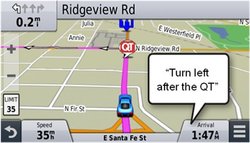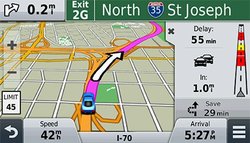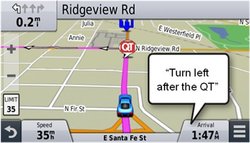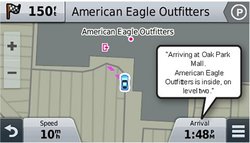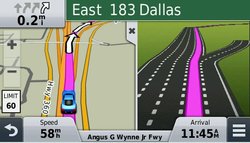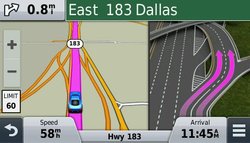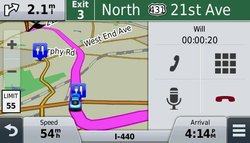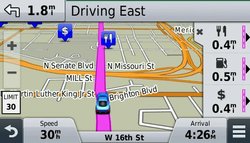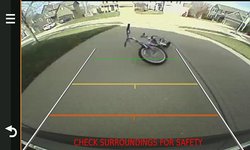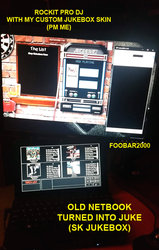I guaranty you it both transmits and receives. You can argue all you want but I have 2 of these and yes they both do transmit and receive in real time. Even when I am out of cell range. In fact when you power it up it tells you it is acquiring satellites and it has an icon that tells you how many sats it's talking to. It need 3 to work but it can link up to 5 sats and it has an icon that shows you how many sats your connected to. If you bother to read the advertisement, it tells you it does not use cell towers. But you didn't read and you don't have one do you?
Advanced GPS Car Navigation
- 7-inch pinch-to-zoom display
- Detailed maps of North America with free lifetime¹ map updates and traffic avoidance²
- Find new and popular restaurants, shops and more with Foursquare®
- Bluetooth® technology for hands-free calling³
- Voice-activated navigation allows you to keep your hands on the wheel
Bright Display
nüvi 2789LMT has a bright 7-inch display with pinch-to-zoom capability, so you can quickly get a closer look at any onscreen information.
Detailed Maps with Free Updates
nüvi 2789LMT arrives loaded with detailed maps of North America. With free lifetime¹ map updates, your routes are sure to reflect the most up-to-date maps, points of interest (POI) and navigation information available. New maps are available for download for the useful life of your GPS device, with no fees.
Foursquare Adds Millions of New POIs
View attachment 50380
With so much data, nüvi 2789LMT makes it easy to find addresses and millions of POI – that is, businesses, stores, restaurants or other destinations. Our POI database also includes accurate, relevant information sourced from Foursquare. Now, when you search, the most relevant Foursquare result appears at the top of the list. It’s an easy way to discover new and popular restaurants, shops and more.
When you use the
Smartphone Link app with your nüvi 2789LMT, you can also check-in on Foursquare and access more detailed information about the POI, including ratings, price range and hours of service.
Free Lifetime Traffic Avoidance
View attachment 50381
nüvi 2789LMT features Garmin traffic to help you spend more time on the move. With Garmin traffic, your driving map remains onscreen at all times. Traffic alerts appear to the side of your map and messages are spoken, too. Garmin traffic can give details about the situation, such as how many minutes of delay to expect and if there are any possible detours. It can even confirm whether or not you are on the fastest route. Lifetime traffic² entitles your nüvi 2789LMT to receive free traffic information for its useful life, with no ads and no subscription fees. Garmin traffic is delivered straight to your nüvi – no smartphone needed.
Garmin Real Directions™
View attachment 50382
Drive with confidence, even when you’re out of cell phone range. nüvi 2789LMT is dedicated automotive navigation that does not rely on cellular signals and is unaffected by cellular dead zones.
nüvi 2789LMT redefines “spoken turn-by-turn directions” with Garmin Real Directions, easy-to-understand driving directions that guide like a friend, using recognizable landmarks, buildings and traffic lights. No more stress from trying to read street names. Instead, hear clearly spoken guidance, like “Turn left after the gas station.”
Find Exactly Where You Need to Go
View attachment 50383
The Direct Access feature simplifies navigating to select complex destinations, like airports and shopping malls, by finding a place within a larger location. When navigating to the mall, Direct Access gives additional location information for specific retail stores inside. For example, "Arriving at Woodfield Mall. Anthropologie is inside, on the upper level." Direct Access even navigates through parking lots to find the entrance nearest your destination.
Easily Navigate Complex Interchanges
Active Lane Guidance with voice prompts prepares you to drive through an exit or interchange with confidence. As you approach, an animated model uses brightly colored arrows to indicate the proper lane needed for your route; a friendly voice offers additional help. Bird’s Eye junction view offers a detailed view of interchanges, looking down as if from overhead. photoReal Junction View realistically displays junctions and interchanges along your route, including the surrounding landscape. Brightly colored arrows indicate the proper lane to drive. nüvi 2789LMT also depicts real road signs as they appear along your route.
View attachment 50384 View attachment 50385 View attachment 50386
Bluetooth® Compatible
View attachment 50387
Sync a Bluetooth-enabled device³, such as your smartphone, to nüvi 2789LMT for hands-free calling through its integrated microphone and speaker. Stow your phone in your pocket, purse or console and still make and take calls.
The Power of Your Voice
View attachment 50388
nüvi 2789LMT has the luxury of voice-activated navigation. Speak, and your device intelligently responds; your hands can remain on the wheel. Of course, you can also navigate using the touchscreen interface.
Smartphone Link Compatible
View attachment 50389
Smartphone Link is a free mobile app that connects your nüvi 2789LMT with your iPhone® or Android™ smartphone. When paired, your nüvi can use your phone’s existing data plan4 to share information – such as where you parked, POIs and your destination. With the Smartphone Link app, you can conveniently send locations and addresses from your phone straight to your nüvi.
Smartphone Link also gives you access to Garmin Live Services5, useful real-time information such as weather. Smartphone Link works with iPhone 4S or later and some Android devices.
More Information At a Glance
View attachment 50390
nüvi 2789LMT keeps your driving map onscreen at all times and additional information appears alongside. For details, simply touch the screen. As you drive your route, Up Ahead constantly informs you of nearby services, including food, fuel and ATMs.
nüvi 2789LMT displays speed limit, current speed and estimated time of arrival. With a quick glance, you can read the name of your current street. nüvi 2789LMT also provides school zone alerts.
View attachment 50391
Add a Wireless Backup Camera
For a complete navigation solution, nüvi 2789LMT pairs with the
BC™ 30 wireless backup camera (sold separately. Professional installation recommended). Once connected, you can easily see vehicles, pedestrians and other obstacles right on the nüvi display, as you move in reverse.
¹
Lifetime Maps Terms & Conditions
²
Lifetime Traffic Terms & Conditions
³Requires Bluetooth®-enabled smartphone (sold separately)
4User’s data plan charges, if any, will apply. Contact your mobile service provider for more information about your service plan’s data and roaming rates.
5Subscription may be required.
The Bluetooth® word mark and logos are owned by the Bluetooth SIG, Inc. Foursquare® is a registered trademark of Foursquare Labs, Inc.
View attachment 50392





